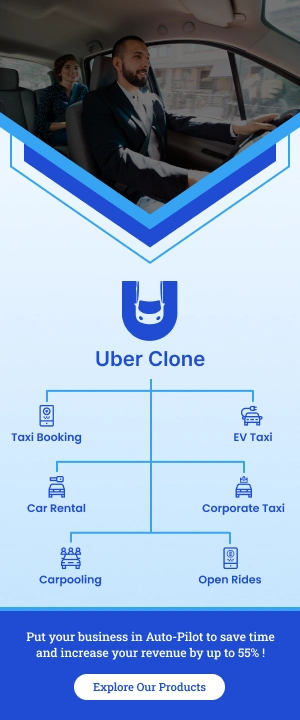
Uber has become a global leader in the ride-hailing industry. The success of Uber motivates entrepreneurs who are looking to build their own successful Uber clone app.
However, to achieve success like Uber, a company needs the right technology stack. Developing a secure, scalable, and robust platform for a ride-hailing service involves integrating various advanced technologies.
Read along to know the steps of choosing the right tech stack for your Uber clone app. To offer a seamless user experience, understanding the right tech stack is critical, and selecting the right technologies plays a key role in ensuring success.
What is a Tech Stack?
A tech stack is a collection of technologies used by companies to develop and implement an application. The Uber clone tech stack consists of the programming languages, frameworks, databases, tools, and cloud services required to build, deploy, and maintain the app. The stack is of two types :
- Frontend : The user interface, or UI, that users interact with.
- Backend : The behind-the-scenes server, API, database, and anything that supports the app.
Choosing the right tech stack for your Uber clone app is critical to ensure the app is performant, scalable, and secure.
Primary Considerations in Selecting the Right Uber Clone Tech Stack
There are several factors to consider before selecting the Uber clone tech stack.
1. Scalability
Scalability is an important aspect as your app grows in terms of users, drivers, and coverage. The technology stack you select must enable your application to meet the emerging demands, and you should be able to accommodate more traffic, users, and requests for rides without affecting the performance.
2. Performance
Ride-sharing apps need to deliver instant feedback to users based on their actions. To ensure a seamless experience, the tech stack must be high-performance, enabling fast responses for tasks like ride booking and real-time tracking.
3. Real-Time Features
Real-time update is one of the most significant functions of a ride-hailing application, including the status of a ride, the location of a driver, and the progress of a ride. User satisfaction and app efficiency are determined by real-time communication.
4. Security
Any ride-hailing service is concerned with security, particularly when it comes to making payments and working with sensitive user data. The technology stack must possess powerful encryption and security measures to safeguard user data.
5. Budget and Schedule
The Uber clone tech stack must also match your budget and deadline. Some technologies might demand higher resources, and thus, a balance should be struck between performance and affordability. Utilizing technologies with shorter development cycles may help you meet the strict deadlines.
6. Maintenance and Future Updates
Think of the future maintenance of the app. A simple to maintain, update, and upgrade tech stack will ensure your app remains relevant and functional in the long term.
Key Technologies Behind an Uber Clone App
What are the key elements of the Uber clone tech stack? Let us take a look.
Backend Technologies
The backend is the heart of your Uber clone app as it processes users’ data, rides, and payments. These are some of the trending backend technologies:
- Node.js : Node.js is a runtime environment based on the V8 JavaScript engine of Chrome. It is perfect with Uber clone apps since it is non-blocking and can be used to process several requests at a time. It is particularly applicable in scalable applications that need high-performance speed, including real-time ride tracking.
- Ruby on Rails : It is a well-known framework for developing efficient and scalable web-based applications. The convention-over-configuration model enables it to be developed quickly, which is a significant advantage of Uber clone app that must be released as soon as possible.
- Python/Django : Python is simple and easy to read, and Django is a high-level web framework that makes development faster. It is a perfect combination of apps that need high performance and scalability, such as Uber clone apps.
- Java (Spring) : Java is popular in large enterprise applications. It is powerful, secure, and scalable, which makes it a good choice to develop intricate ride-hailing applications.
Database Technologies
Database selection is essential to store user information, ride, payments, and other data related to the app.
- MySQL : This is a common relational database management system. It is best suited to store structured data, including user information and ride history and guarantees quick queries and data access.
- MongoDB : It is a NoSQL database that is excellent in managing unstructured or semi-structured data. It can support massive traffic and is scalable, thus an ideal application to use when the traffic is high.
- Redis : Redis is an in-memory, high-performance key-value store that serves as a caching mechanism for real-time data. It accelerates the retrieval of ride information, decreases server load, and improves app performance.
Frontend Technologies
The frontend is the section of the app that people use. It must be dynamic, interactive, and user-friendly. The following are the most excellent frontend technologies of Uber clone applications :
- React : It is a JavaScript library to create interactive user interfaces. It has a component-based architecture, which allows the development and maintenance of complex applications. React is highly performant and has a smooth user experience, which is ideal in Uber clone apps.
- Angular : It is a well-known frontend framework for creating single-page applications. It offers two-way data binding and dependency injection, which is why it is appropriate for scalable ride-hailing applications.
- Vue.js is a lightweight frontend framework. It is flexible and can be easily integrated, and it is a good choice when it comes to the creation of the user interface of an Uber clone app.
Mobile App Development
When it comes to mobile app development for your Uber clone, selecting the right tech stack is essential to ensure performance, smooth user experience, and cost-effectiveness. While React Native and Flutter are excellent cross-platform solutions, your client may prefer a more native approach for Android and iOS apps.
- Android App : Kotlin and Jetpack are great choices for Android app development, offering modern, efficient, and highly scalable solutions.
- iOS App : Swift and SwiftUI are ideal for creating a high-performance iOS app with a seamless user interface.
- React Native : It is a popular framework to create cross-platform apps, and you can create both iOS and Android applications using one codebase.
- Flutter : It is another cross-platform mobile framework that offers fast performance and native capabilities, making it an excellent option for creating high-performance ride-hailing applications.
Real-Time Technologies
Ride-hailing apps must have real-time functionality. The users demand real-time monitoring of the ride, immediate alerts, and quick communication between the driver and the passenger. The most suitable technologies for real-time features are as follows :
- WebSockets : These are full-duplex channels that are suitable for real-time functionality, such as real-time tracking of the rides and driver-rider communication.
- Firebase : It has a real-time database, which synchronizes data among users in real-time, making it excellent for providing real-time ride and chat status updates and notifications.
- React Native : It is a popular framework to create cross-platform apps, and you can create both iOS and Android applications using one codebase.
- Socket.io : It is a JavaScript library that can be used to create real-time event-driven communication between the client and the server. It is ideal for live tracking of rides and keeping users updated on the progress of the rides.
Integrations and APIs
- Google Maps API : Google Maps plays a vital role in geolocation and navigation in the ride-hailing applications. It enables people to monitor their trips and assists drivers in finding the most effective ways.
- Payment Gateway Integration : Payment gateway integration with Stripe, PayPal, and Razorpay is necessary to process secure payments. These services offer a smooth and safe transaction to their users.
- SMS/Email Integration : To enhance communication, services such as Twilio and SendGrid can be integrated to enable automated SMS alerts and email confirmations related to ride bookings, cancellations, and marketing promotions.
Choosing the Right Uber Clone App Development Company
Choosing the right Uber clone app development company to partner with is essential for your project’s success. A good development team will advise on the best tech stack to use, will implement all necessary features, and will make your app secure, scalable, and high-performing.
Choose companies that have experience developing scalable, real-time apps. Look at their portfolio, customer reviews and expertise on the latest technologies. The right company will enable you to steer clear of the common mistakes, control costs, and launch your Uber clone app sooner with the best tech for Uber clone.
Outpace Your Competitors. Leverage Our High-Tech Uber Clone to Build an Enterprise-Grade Ride-Hailing Platform that Gives Competitive Edge.
FAQS
The best tech for an Uber clone application usually comprises:
- Server-side processing using technologies such as Node.js, Ruby on Rails, or Python/Django.
- Responsive user interfaces built with frontend technologies such as React, Angular, or Vue.js.
- Real-time technologies such as WebSockets, Firebase, or Socket.io for live tracking of rides and communication.
- Use MySQL for structured user profiles and trip histories, MongoDB for flexible trip logs, and Redis for caching frequently accessed data.
- Scalable infrastructure on cloud platforms such as AWS or Google Cloud. Together, these parts enable the system to perform smoothly, to scale, and to have real-time features.
